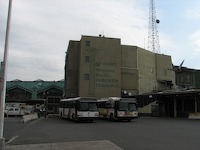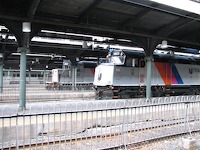 HBLR
HBLR 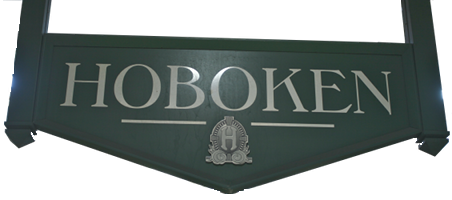
Hoboken Terminal is the one terminal surviving in passenger service of what were once five major Passenger Rail Terminals on the New Jersey Side of the Hudson River Waterfront. The Central Railroad of New Jersey's Communipaw Terminal survives in Liberty State Park but lacks any Railroad Access. Each terminal was designed for passengers to transfer from trains to ferries for the last mile across the Hudson River and into New York City. These ferry boats operated by the railways also provided the only way for vehicles and goods to cross the Hudson until the Holland Tunnel opened in 1927. The intermodal nature of the terminal means NJ Transit lists both PATH and New York Waterway Ferry Connection times at Hoboken in timetables for trains to and from the terminal.
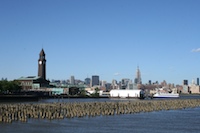
History:The Beaux-Arts Hoboken Terminal was built by the Delaware, Lackawanna and Western Railroad, designed by Kenneth Murchinson and opened on February 25, 1907. It is the fifth railroad terminal on the site and replaced a wooden terminal built in the 1880s that burned to the ground in 1905. The terminal is located at the southern side of Hoboken and portions of the rail yards beyond the terminal are within Jersey City. The outside of the terminal is clad in ornamental copper and gives it a quite greenish quality. The attacked ferry berths and terminal was designed to allow boarding of double ended multi-level ferry boats and to handle both foot passengers on the upper decks with direct access from the train terminal and road based transportation (horses and wagons, and motor vehicles) on the lower deck with access from the road plaza (now called Warrington Plaza) at the northern end of the station. The train platforms are covered by an innovative, low hanging train shed designed by DL&W chief engineer Lincoln Bush. This low train shed provides full covering for passengers getting on and off trains (and a fully covered walkway through the station and onto the connecting ferries) but provides gaps above the tracks for ventilation purposes of the steam locomotives. They were replicated at other major train stations and are known as Bush train sheds for their innovation here.
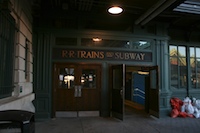
On February 25, 1908 the station received an underground connection into Manhattan with the opening of the Hudson & Manhattan Railroad (still operating today as PATH) beneath the terminal. For long-distance trains, the terminus was the terminal of Lackawanna Trains operating as far as Buffalo with through Sleepers conveyed all the way to Chicago. These trains were marketed by a famous, fictional women, the Phoebe Snow for the fact the Lackawanna used only anthracite coal, a much cleaner burning fuel than regular coal. From September 1930 to January 1931 the Lackawanna Railroad electrified its commuter lines including the Hoboken Terminal to Montclair, Gladstone and Dover via the Morristown Line with Thomas Edison at the throttle of the first MU train. Electric services continue to this day.
The 1950s began a decline and consolidation of railroads on the New Jersey Waterfront. The original clock tower (visible from the New York City Shore) at the station had to be taken down after storm damage. From 1956 to 1957 the Erie Railroad rerouted its operations into the Hoboken Terminal, sharing it (and the costly connecting ferry service) with the Lackawanna Railroad. The Erie terminal and ferry service finally closed in 1958. These two railroads merged into the Erie Lackawanna Railway in 1960. The New York Central's Western Division closed its Weehawken Terminal and ended all passenger train and ferry operations in 1959. In 1961 the Pennsylvania Railroad closed its Exchange Place terminal to passenger operations and rerouted all trains directly into New York City's Pennsylvania Station (opened in 1908). On April 25, 1967 the CNJ's Communipaw Terminal closed and ferry service from there was discontinued. All trains were severed from the Waterfront (except for an RDC Shuttle from Bayonne to Cranford) rerouted via the Aldene Connection into Newark-Penn Station (where passengers transferred to PATH or Pennsylvania Railroad trains into Penn Station to reach New York City). On November 22, 1967 the last double ended, double-decker (accommodating both passengers and cars) Eire Lackawanna operated Ferry Boat crossed the Hudson from Hoboken to Barclays Street. This ending 300 years of ferry service across the Hudson River. All commuters forced to now transfer to PATH at Hoboken to cross the Hudson instead of ferries.
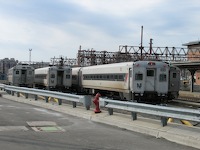
The last Erie Lackawanna long distance trains from Hoboken also began to make their final runs. On November 27, 1966 the Phoebe Snow to Buffalo, the one Lackawanna Operated Streamliner (introduced in 1939) was discontinued. The final long-distance train to Chicago, the Lake Cities (former Eire) ended on January 6, 1970 delegating Hoboken Terminal to Commuter Service only. Starting in the 1960s the State of New Jersey began subsidizing commuter rail operations for the Erie Lackawanna, the largest commuter rail provider in the state. This included cash operating subsidies and buying the Eire Lackawanna new cars starting in 1970 (the now retired Comet-Is). In 1976 the bankrupt Eire Lackawanna was absorbed by Conrail who continued to use state subsidies for Commuter Rail operations. In 1983 the rules of the brake-up of Conrail required it to no longer run passenger service. This required states to form their own railroads to continue to run passenger service. In New Jersey, New Jersey Transit was created and Metro-North Railroad for upstate Conrail operations in New York. New Jersey Transit assumed all operations from Hoboken Terminal and was contracted to run the Metro-North owned West of Hudson division operations of the Port Jervis and Pascack Valley Lines into Rockland and Orange Counties in New York State.
The New Jersey Transit takeover and continuing development of the former rail yards saw the reintroduction of ferry service across the Hudson in 1987 from Weehawken. In 1989 the route from Hoboken to the World Financial Center was reintroduced, a joint venture of the Port Authority, Hartz Mountain Industries and Arcorp Properties. Eventually New York Waterway became the operator. These ferries originally left from a 'temporary' tent barge dock just south of the historic terminal. This temporary dock operated for over 22 years until December 7, 2011 when four of the ferry slips in the intermodal terminal were reopened.
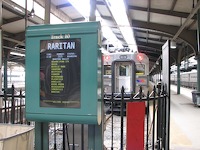
New Jersey Transit implemented a number of capital programs in the 1990s mostly diminishing Hoboken's role as a transfer station for Trans-Hudson commuters. On September 9, 1991 the Waterfront Connection opened allowing CNJ (Raritan Valley Line) and Pennsylvania Railroad (the Northeast Corridor and North Jersey Coast Line) trains to reach the Hudson River Waterfront again after a 25 to 30 year hiatus and terminate at Hoboken. The rest of the railroad's projects diminished the role of Hoboken Terminal for transferring passengers. The Kearny Connection opened on June 10, 1996. This created midTOWN DIRECT trains and allows for a one seat ride into New York-Penn Station for passengers on the electrified portions of the Morristown Line (from Dover) & Gladstone Branch bypassing Hoboken. The Montclair connection opened on September 30, 2002, redirecting most electric Montclair-Boonton Line as midTOWN DIRECT trains into New York-Penn Station. The final change was the opening of Secaucus Junction on December 15, 2003. This station connected the diesel Main, Bergen County, Port Jervis and Pascack Valley Line trains with the electric Northeast Corridor, North Jersey Coast and midTOWN DIRECT trains and allowed passengers on the diesel lines to reach New York City (as well as providing easy connections between all NJT rail destinations) entirely by NJ Transit trains instead of via PATH or Ferries from Hoboken.
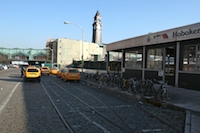
The station has always been an important stop for local connections to the small city of Hoboken and northern Jersey City. These were first provided by streetcars in a two-level terminal just north of the station platforms (some tracks still survive in the cobblestones of Hudson Place where the taxi stand is). In 1949 the streetcars were discontinued and replaced by buses that still depart north of the rail platforms with 5 bus bays beneath a canopy structure just north of the station platforms. The beams that hold up this canopy originally supported the trolley terminal. On September 29, 2002 modern streetcars in the form of light arrived at the station once again with the Hudson-Bergen extension. The light rail stops on the opposite, southern side of the terminal along the Hudson River. Beginning in 1996 the station was restored and in Spring 2008 in honor of the station's centennial, a new historically accurate replacement clock tower was erected on top of the station. This is visible from miles around, including in Manhattan and is lit at night with lettering spelling out Lackawanna.
Current Service and Layout:
Rail operations to the station today on the former Erie Lines at off peak hours and on weekends consist of trains about hourly on the Main Line and Bergen County Line, with some combined (making local stops in New Jersey) and some express Metro-North trains to Port Jervis. Pascack Valley Line trains (through operations) run roughly every other hour with a few Metro-North Expresses (even on weekends). These lines see a greater increase of service during rush hours.
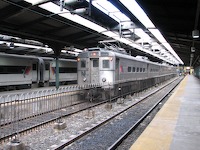
The Ex-Lackawanna Lines during weekdays, from Hoboken see hourly electric MU Gladstone Branch trains, supplemented by infrequent diesel trains running all the way to Hackettstown. During rush hours there is an increase of service including some electric trains on the Morristown Line to and from Dover. Montclair-Boonton Line trains operating to and from Hoboken during the week is all diesel service to Hackettstown running via on the Boonton Line (operating peak direction rush hours only) and a few supplemental rush hour electric trains to and from Montclair. Weekend service on these former lines is extremely limited with just electric service every two hours to and from Montclair-Bay Street (the only weekend service on the entire Montclair-Boonton Line).
Waterfront Connection (the ex-CNJ and Pennsy Lines) service is extremely limited to weekdays only with just five rush hour diesel North Jersey Coast Line Trains and one AM rush hour arrival on the Raritan Valley Line. For some years (starting at some point before 2003 until 2007) every other weekend Raritan Valley Line train was extended to Hoboken, providing bi-hourly service to Newark-Penn Station on weekends.
The station is also unique because it has entirely low-level platforms. Wheelchair passengers are requested to arrive at the station 15 minutes before so the crew can use a mobile for boarding (it is the only station in New Jersey where mobile lifts are used). The reason for this is because the stations platforms are still covered by a green Bush-type train shed that dates to the station's opening. This train shed is relatively low and held up by numerous green iconic columns along the 9 platforms it covers, there are open gaps allowing natural light in above the track areas, and more importantly an area for ventilation of the steam locomotives. The catenary system is directly suspended from the roof.
The train shed covers 15 of the station's 18 tracks. Track 1, the northernmost track is half the length of the rest of the tracks cut off from the main station by a wide plaza and the entrances to the covered Hoboken Bus Terminal (with 5 bus bays) and PATH. Track 14 has a platform on each side but only boards from the platform shared with track 13. This gives track 15 (slightly shorter than the rest of the tracks) its own platform (although technically Track 14 could also open on this platform on two sides) with the train shed ending on the edge of this track. Tracks 16 and 17 are located just south of the train shed and have there own slightly more modern simpler canopy covering them and have slightly shorter platforms. The directory maps for the station show track 18 without a platform. This track is at the southern end (near some other siding tracks) with the Hudson Bergen Light Rail platforms just south of it. It short of has an open air platform. All of the platforms have been modernized with yellow tactile warning strips. Signage throughout the station is in its own unique green style with a Serif font.
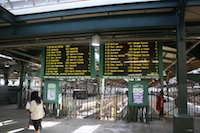
All the platforms are connected by a public walkway beyond the gates at the end of the platforms that is covered by the bus train shed that also provides the only access to the platforms beyond the bumper blocks. This walkway is a continuous public thoroughfare called the Waterfront Walkway that follows the Hudson River Waterfront. The southern end of it continues south along the water, past the HBLR platforms and into the Newport Development of Jersey City. This promenade opened in 2009. The northern end leads beyond the main entrances to PATH, the edge of the Bus Terminal and to Warrington Plaza and the streets of Hoboken continuing along the water. Along this walkway at the edge of the tracks are LCD screens that display upcoming train information at each track (along with advertisements when trains are not boarding). There are two modern yellow LED departure boards beyond the bumper blocks of tracks 12 and 13 that give next train departure information. There are also a few television screens throughout the complex for track and next departure assignments colored by the respective train lines. There are also quite a few TVMs for ticket purchases along the walkway.
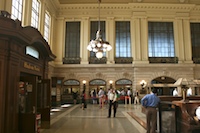
Along the other side of the covered walkway is the side of the train depot. There are a series of shops including a few restaurants, bars, and a liquor store called Lackawanna Liquors. The customer service office is at the southern end of the building, accessed from outside, across from Tracks 13 and 14. The entrances to these areas all of green facades that try and look historical. Along the walkway is a closed staircase up to doors that have lettering for To Upper Deck of Ferry Boats. The most important doors are the six (between tracks 9 and 5) that lead into the wonderfully restored waiting room. In the center are 3 long wooden benches with light fixtures above them. Amenities inside only include a shoe shine, newsstand, and the NJ Transit ticket office. This waiting has a double-height ceiling, a grand staircase along the east wall that once provided another way to the Upper Level of the Ferry Boats. The walls have marble lower halves and white upper plaster above with windows that let plenty of natural light in. High on one wall is a golden clock. The ceiling has quite a lot of gold leaf and a stained tiffany glass skylight. The Tiffany glass extends to signage above various doors: To Trains, Tickets Mens Room, the closed (to passengers, now a crew area) Lunch Room, To Restaurant (now above payphones).
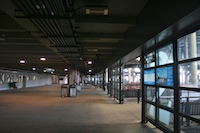
Starting in December 2011 ferries finally began leaving from the 5 restored ferry slips where the double-end ferries left from until 1967. From the waiting room passengers go out doors between the staircases that used to lead to the upper decks of the ferries. This leads to an extremely modern ferry area with a concrete floor. No ferry will ever leave from this terminal again with entry to an upper level. Silver walls are along the wall of the station. Along one wall are three windows for Tickets & information. An exterior exit leads to Warrington Plaza. To reach the actual ferries slips passengers must go up some steps or a ramp to reach the actual five slips. These have movable modern glass petitions to close them off. The ferry slips themselves have modern gangways surrounded by what are designed to look like wooden bridges. The facade of the building over the water remains intact and ferries still arrive and depart beneath a large sign for the Erie Lackawanna Railroad. A silver wall has been built where vehicles used to enter the terminal to continue to Warrington Plaza. The silver walls have cuts outs from them revealing a panel behind with silhouettes of individuals. This is The Other Side of the River by Kate Dodd, 2011.
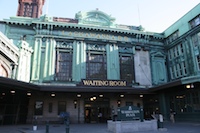
There are doors lead out from the waiting room, the edge of the ferry terminal closest to the depot, and even from the station walkway itself — from right next to the closest entrance to PATH, with "R.R. Trains and Subway," written in gold leaf — to Warrington Plaza. Warrington Plaza is the modern name for what was once the entrance for vehicle traffic to the ferry boats. It is no longer open to public vehicle traffic and is at the dead end of Hudson Place. Here is the best close up view of the limited streetside facade of the building. The back of the ferry docks is still covered in construction equipment with newly erected walls beneath a second floor of windows (some with air conditioners) in the copper upper facade with gabled roofs. Faint lettering still says 'Ferries to New York.' The waiting room has a similar green copper facade. This area has a high suspended brown awning above the entrance doors to the waiting room. A large gold leaf sign on brown says 'Waiting Room' on the front of the awning. Lackawanna Railway is in gold on top of the copper facade. The recently rebuilt clock tower (a brown color) is located on the roof of the building just beyond it. The building extends out a bit still covered in copper and divides Warrington Plaza from the bus loop which makes track 1 shorter. The backside of this building near the five bay covered bus loop has been modifed with an ugly concrete facade and NJ Transit Welcomes You to Hoboken Terminal stenciled on it in large letters next to a column.
Superstorm Sandy:
Being at sea level, the rail yards and waiting room were flooded (in the waiting room the floodwaters were five feet high) during Superstorm Sandy at the end of October 2012. This totally ruined the substation for electric operations into the terminal. All train service was suspended for over a week with limited service from Port Jervis via the Main Line finally starting to resume on November 6, 2012, and the other branches slowly returning, with Gladstone Branch service finally returning on December 3, 2012. The electrical catenary system into the station was fried. Service on the Morris & Essex Lines and the Gladstone branch normally that normally uses Arrow MU cars is operating using NJT's new dual-mode Bombardier ALP-45DPs. These trains run under diesel out of Hoboken to Newark Broad Street where the pantograph is raised for electric operations to the final destinations. Electric Service into Hoboken was finally restored with the rebuilding on the substation on Sunday, March, 24, 2013. The Hoboken PATH station was extensively damaged from flooding and service didn't resume there until December 19, 2012.
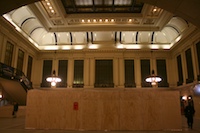
The station building was originally thought to be fine after a thorough scrubbing from the mud the Hudson River left behind and was fully reopened to the public in November. On December 19, the waiting room and entire building was closed by experts concerned about mold build-up from the floodwaters. The ticket offices and customer service office are now relocated to separate trailers outside along the walkway that connect the tracks. All of the stores are also closed for cleaning and mold prevention. Restrooms were originally inside an idling 'warming' train and soon in a number of port-a-johns scattered outside the station in Warrington Plaza. The building was given a much more thorough cleaning and the waiting room reopened on January 29, 2013. When it reopened the building still lacked indoor plumbing with port-a-johns in Warrington Plaza. The ticket and customer service offices are still in trailers outside. Large plywood boxes are in the middle of the grand waiting room, the historic wooden benches still being restored. The Tiffany windows and some of the doors are covered in plastic tarps for protection. Plumbing was restored with the restrooms reopening in August 19, 2013. The historic wooden benches took even longer, a full year, to rebuild and they were finally returned to passenger seating in November 2013. The foot court finally fully reopened in January 2014.
